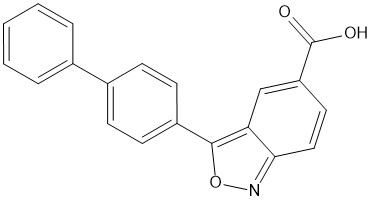UNC7467 | IP6K inhibitor

Available Options
| Size | Price | Quantity | |
|---|---|---|---|
| 5mg | $55.00 | ||
| 25mg | $230.00 |
UNC7467 (2922283-43-8) is a potent inhibitor of inositol hexakisphosphate kinase (IP6K) – the isoform IP3K1 regulates metabolism, promotes insulin secretion from ß cells, attenuates certain aspects of insulin signaling, and reduces whole-body energy expenditure by inhibiting adipocyte thermogenesis, thus making it an attractive target for treatment of obesity and obesity-induced metabolic dysfunction. It is selective for IP6K1 and 2 over IP6K3 (IC50s = 8.9 nM, 4.9 nM, and 1320 nM respectively). EC50 = 1.0 µM and 0.24 µM at 3hr and 18 hr respectively in intact HCT116 cells ([33]P-Pi efflux). Selective against a panel of 30 protein kinases and 5 CYP isoforms. UNC7467 improved glycemic profiles, ameliorated hepatic steatosis, and reduced weight gain without altering food intake in diet-induced obese mice.
References/Citations:
- Zhou et al. (2022), Development of Novel IP6K Inhibitors for the Treatment of Obesity and Obesity-Induced Metabolic Dysfunctions; J. Med. Chem. 65 6869
C20H13NO3
>98% TLC
NMR (Conforms)
Safety Data Sheet:
Product Data Sheet:
Materials provided by Focus Biomolecules are for laboratory research use only and are not intended for human or veterinary applications. Please note that we do not sell to individuals and that all orders placed by non-research organizations will incur a $20 restocking/refund fee
UNC7467 (2922283-43-8) is a potent inhibitor of inositol hexakisphosphate kinase (IP6K) – the isoform IP3K1 regulates metabolism, promotes insulin secretion from ß cells, attenuates certain aspects of insulin signaling, and reduces whole-body energy expenditure by inhibiting adipocyte thermogenesis, thus making it an attractive target for treatment of obesity and obesity-induced metabolic dysfunction. It is selective for IP6K1 and 2 over IP6K3 (IC50s = 8.9 nM, 4.9 nM, and 1320 nM respectively). EC50 = 1.0 µM and 0.24 µM at 3hr and 18 hr respectively in intact HCT116 cells ([33]P-Pi efflux). Selective against a panel of 30 protein kinases and 5 CYP isoforms. UNC7467 improved glycemic profiles, ameliorated hepatic steatosis, and reduced weight gain without altering food intake in diet-induced obese mice.
References/Citations:
- Zhou et al. (2022), Development of Novel IP6K Inhibitors for the Treatment of Obesity and Obesity-Induced Metabolic Dysfunctions; J. Med. Chem. 65 6869
Related Cancer Cell Metabolism Metabolic Kinase Products
Download
Calculate the molar concentration, mass or volume in a solution.
Concentration × Volume × Molecular Weight = Mass
Focus Biomolecules • Plymouth Meeting, PA USA • 1-855-FOCUS21
Focus Biomolecules
Plymouth Meeting, PA USA
1-855-FOCUS21
Website Created by Advanta Advertising LLC.

